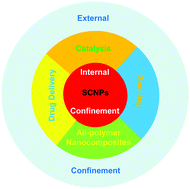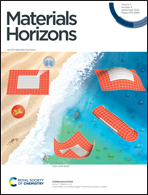Single-chain nanoparticles: opportunities provided by internal and external confinement
Abstract
In recent decades, self-confinement effects arising from the folding of individual synthetic polymer chains to single-chain nanoparticles (SCNPs) have been exploited for the construction of efficient enzyme-mimetic catalysts, improved drug delivery nanosystems and innovative sensing nanomaterials, among other uses. Remarkably, the imperfect folding of a unimolecular synthetic chain to a functional soft nano-object resembles – to some extent – the folding of a protein to its native, functional state. However, the huge possibilities that can be deployed by determining how external confinement modulates the structure, dynamics and properties of SCNPs have not been totally appreciated yet. In this article, after considering the opportunites that internal confinement in SCNPs offers for catalysis; encapsulation, transport and delivery of therapeutic cargos; and sensing, targeting and bioimaging applications, as well as other diverse advanced applications, we try to provide a unifying vision of what is the expected effect of external confinement – as imposed under different geometrical constraints as well as in solution, in the melt state, on surfaces and in membranes – on the size, shape and, hence, potential functionality/foreseen applications of SCNPs. We anticipate a plethora of opportunities that open up arising from external confinement of SCNPs: from innovative purification techniques and improved all-polymer nanocomposites, to smart responsive surfaces and new topological nanostructures.



 Please wait while we load your content...
Please wait while we load your content...